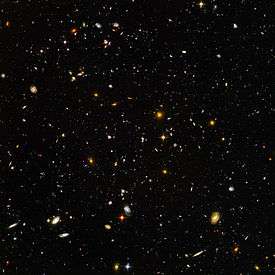Deep space exploration

Deep space exploration (also deep-space exploration) is the term used for the exploration of deep space, within or away from the Solar System. It is the branch of astronomy, astronautics and space technology that is involved with exploring the distant regions of outer space.[1] Physical exploration of space is conducted both by human spaceflights (deep-space astronautics) and by robotic spacecraft.
At present the furthest space probe mankind has constructed and launched from Earth is Voyager 1, which was announced on December 5, 2011[2] to have reached the outer edge of the Solar system,[3] and entered interstellar space on August 25, 2012.[4] Deep space exploration further than this vessel's capacity is not yet possible due to limitations in the space-engine technology currently available.
Some of the best candidates for future deep space engine technologies include anti-matter, nuclear power and beamed propulsion.[5] The latter, beamed propulsion, appears to be the best candidate for deep space exploration presently available, since it uses known physics and known technology that is being developed for other purposes.[6]
Outdated research
In 2012, the Defense Advanced Research Projects Agency announced the award of $500,000 to former astronaut Mae Jemison to fund a project with the goal of sending future astronauts out of the Solar System. Jemison aims to increase public interest in future deep space exploration projects.[7] Upon awarding the money to Jemison, a "100 Year Starship" symposium was held in Houston, Texas to discuss interstellar travel. Topics discussed include "time-distance solutions; life sciences in space exploration; destinations and habitats; becoming an interstellar civilization; space technologies enhancing life on earth; and commercial opportunities from interstellar efforts".[8]
Research in deep space is ongoing and rapidly developing. In 2011, after the retirement of the space shuttle, NASA announced its intentions to invest money into developing three technologies vital to deep space exploration. The "must-have technologies" include a deep space atomic clock, a large solar sail and a more advanced laser communications system to improve communication, navigation, and propulsion in future missions.[9] In June 2013, NASA announced the selection of eight American astronauts that will begin to train for future deep space missions beyond low Earth orbit. NASA intends that these eight astronauts to train for future Mars or asteroid travel.[10]
The Single Aperture Far-Infrared Observatory (SAFIR), a proposed cryogenic space telescope, is tentatively set to launch in 2015 with the hopes of exploring "the formation of the first stars and galaxies" in deep space. The telescope will be more than 1000 times more sensitive than two current telescope spacecrafts, the Spitzer Space Telescope and the Herschel Space Observatory. NASA hopes to use SAFIR to learn about black holes, galaxy formation and evolution and the formation of star systems in the far reaches of space.[11]
See also
- Intergalactic travel
- Interplanetary spaceflight
- Interstellar travel
- List of artificial objects leaving the Solar System
References
- ↑ "Space and its Exploration: How Space is Explored". NASA.gov. Retrieved 2009-07-01.
- ↑ http://voyager.jpl.nasa.gov/news/new_region.html
- ↑ "The Farthest Spacecraft". NASA.gov. 1998-02-24. Retrieved 2009-07-01.
- ↑ Bryn, Brandon (2013-09-12). "Voyager 1 Now Probing Unexplored Region of Space". Science.
- ↑ "Future Spaceflight". BBC. Retrieved 2009-07-01.
- ↑ Forward, Robert L (January 1996). "Ad Astra!". Journal of the British Interplanetary Society. 49: 23–32. Bibcode:1996JBIS...49...23F.
- ↑ Vastag, Brian (May 22, 2012). "Starship dreamers launch 100-year mission with DARPA grant". The Washington Post.
- ↑ Moskowitz, Clara. "Interstellar Starship Meeting Warps Into Houston This Week". Space.com. Retrieved November 22, 2013.
- ↑ Wall, Mike. "NASA Picks 3 Pioneering Technologies for Deep Space Travel". Space.com. Retrieved November 22, 2013.
- ↑ Moskowitz, Clara. "NASA Unveils New Astronaut Class for Deep-Space Exploration". Space.com. Retrieved November 22, 2013.
- ↑ "SAFIR - Single Aperture Far Infrared Observatory". NASA. Retrieved November 22, 2013.
12.
External links
- Human Space Flight at NASA.gov
also check out solarsystem.nasa.gov
